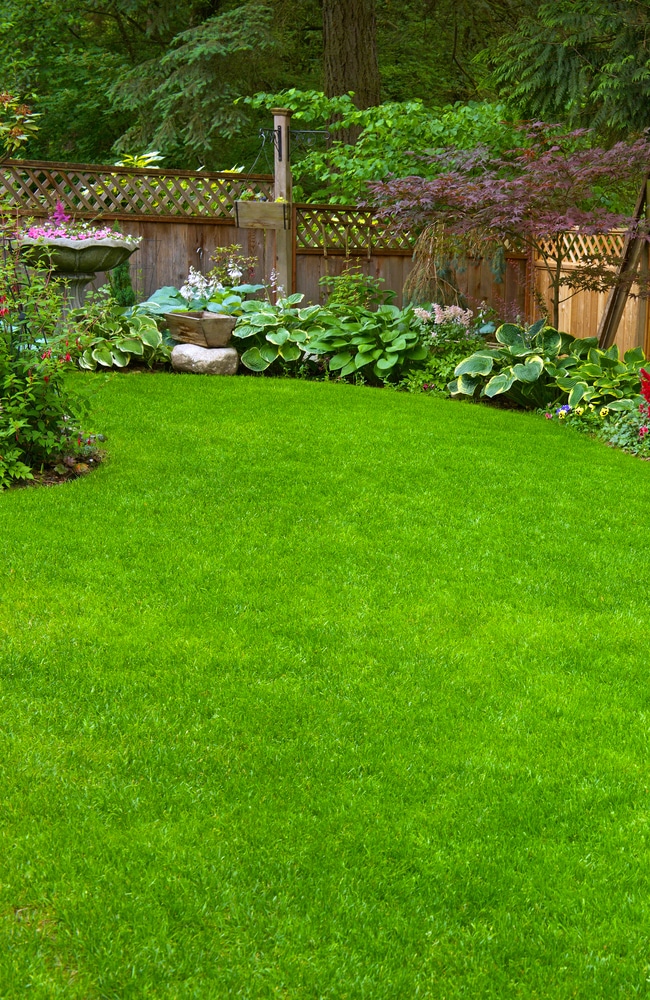Think of the perfect, weed-free, emerald tones of a golf course.
Like many homeowners, it’s likely that you’ve wondered how you could make your grass look that pristine. That deep green, free of dandelions or any of the other common weeds that plague homeowners, is attainable. But it takes some know-how, as well as the willingness to look at tried-and-true, possibly old-fashioned, solutions.
One essential top dressing, used properly and timed right, can both fertilize your grass and weaken and kill weeds.
Interested in learning more? It’ll change your approach to lawn care, and give you that pristine green carpet you’ve been dreaming of.
Also make sure to read our article on taking care of Bermuda grass to make sure your lawn can remain a uniform, beautiful luscious green.

What is Lawn Sand?
Lawn sand is a fine, granular top dressing that consists of 3 different ingredients.
The first and most obvious is sand. Used in this capacity, the sand is only beneficial to lawns in a very small way. Its primary purpose is to act as an effective delivery system for the other chemicals, which we’ll be covering next.
The second ingredient is iron sulfate. Iron sulfate, also called ferrous sulfate, is commonly used to kill moss and prevent moss infestation. This is especially important for those wet, shady parts of your yard.
The third ingredient is ammonium sulfate. This chemical compound is often sold as a stand-alone fertilizer that is popular with homeowners. It mostly provides nitrogen and sulfur, which helps both fertilize your grass and improve alkaline soil, which results in a healthier, greener lawn.
Why Use It?
Have you ever been out on a golf course? If you have, you surely noticed how well-maintained the entire landscape was from the tee box of the very first hole. The lawn care professionals out on the courses have several tricks up their sleeve when it comes to meticulously manicuring their grass.
One of those tricks is using lawn sand, which is used to treat the putting greens of most golf courses in the world today.
Why is that?

You already know that the iron sulfate kills moss. It also provides several other benefits for lawns in addition to being an efficient moss killer. It benefits soils and grasses by making them more resistant to disease. It also helps the ground drain more efficiently.
This compound also kills broadleaf weeds in your lawn by scorching them. This, in turn, will turn the weeds black, so they are easily identifiable during removal. Conversely, it also gives your grass a deep, green color.
The ammonium sulfate in lawn sand is a chemical material rich in nitrogen. Nitrogen supports the strong and healthy growth of plant life in your yard.
It’s also very useful if you have a thatch problem in your yard. The chemicals in this top dressing will help break down the thatch layer you have in your lawn.
As the sand fertilizes the soil over time, the overall pH level of the earth is lowered. This is great for lawns with grasses that thrive in acidic soil. Bahiagrass, bermudagrass, and centipede grass are a few that come to mind.
Do a little research if you aren’t sure about the grass in your yard.

If you want a healthy lawn, you will also need to make sure to water it properly. This includes watering it the right amount and at the correct time of the day.
How Does It Work?
This top dressing works as a weed and moss killer because of its physical structure. The grains are extremely fine and very dry. These two characteristics allow it to rest on surfaces instead of sticking to them.
As you know, grass grows vertically up from the soil while broadleaf weeds and moss grow outwardly.
When the sand is applied, it will settle on the weeds and moss in your lawn because the grains have something to land on.
Because grass grows upright, the sand cannot settle on the blades. Instead, they fall between the blades of grass, onto the soil. This allows the chemicals in the sand to fertilize the soil, which nourishes the root systems of turf grasses.
So, interestingly, lawn sand is actually a selective weed killer.

When Should You Apply It?
The best time to apply it is in the spring.
Generally speaking, you’re looking at somewhere between the end of March and the middle of April. However, the perfect moment for you depends on the weather where you live.
As the weather begins to warm up after the cold winter months, you should start to see signs of the grass coming out of its winter hibernation. When you start to see this new growth, you can go ahead and apply the top dressing.
Remember that you aren’t just setting out to kill moss and broadleaf weeds. You’re also fertilizing the soil. If you apply it too early, the soil may be too cold for that nitrogen-rich compound to do its job.
You should avoid applying this top dressing in periods of drought or extremely dry conditions. The two chemical compounds of the sand could potentially scorch the grass.
There are some important gardening tips to remember when it comes to timing your top dressing application.
You should apply it in between mowing sessions. Try to make sure you apply it at least three days before and after a mowing session for maximum benefit. For example, if you mow once per week, you should apply the sand on day four. That gives you three days in both directions.

Timing it this way will ensure the grass is short enough to guarantee better coverage of the moss and weeds and ensure the chemicals in the sand have time to absorb into the soil before the next mowing session.
Another tip when trying to time your application is to do so when the conditions are right. The right conditions would be a calm day with no wind and no rain in the forecast. These are chemical compounds that could potentially be hazardous to you. Not to mention that the ferrous sulfate will stain any and everything that it comes into contact with.
If the earth on your property consists of clay soil, you should not apply the sand to the ground. It will not penetrate the soil. In fact, it will weigh down on the clay and make it impossible for water and nutrients to circulate through it. The only exception to this rule is if you aerate the ground first. Then the sand might integrate with the clay and work to loosen it up.

How to Apply Lawn Sand
There are two ways to apply this fertilizing and weeding combo to areas of your property: by hand or by spreader. The method you choose is up to you, but the steps for both methods are the same.
Step 1: Prepare the Yard
Mow the yard three days before you plan to apply the sand. This will expose the moss and weeds you intend to get rid of and make it easier for the top dressing to reach the dirt.
Step 2: Check the Conditions Outside
Step outside to see if the wind is blowing. Remember that you’re spreading a small, light, granular substance that will drift in the breeze. You don’t want to get this stuff in your eyes. Don’t apply if you are in a drought. You’ll do more harm than good if you try to apply it in less-than-ideal conditions.
Step 3: Check the Label on the Bag
You should inspect the label on the back of the bag to determine the amount to apply per square foot of grass. Under-application may not be effective, while over-application can scorch the ground.
Step 4: Divide It
Split the correct amount of sand into two equal parts. This will make sense in a moment.
Step 5: Spread It
Take one of the equal parts of sand and put it into a spreader. Use a container if spreading by hand. Walk the entire area of your lawn back and forth vertically just as you would if you were mowing your yard. This ensures an even layer of distribution.

Step 6: Spread the It Again
Put the second equal part of sand into your spreader or container. Walk the entire area of your yard horizontally. Back and forth in the same manner as you made the vertical passes.
If you plan on applying grass seed, you should do so after spreading the sand in both directions.
Step 7: Water the Lawn
Within 48 hours of application, you need to water thoroughly. Watering will aid in the absorption of the ferrous sulfate that fertilizes the ground. Do not let anyone or anything walk on the lawn before it has been watered.

